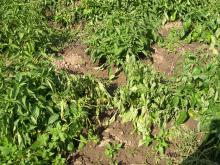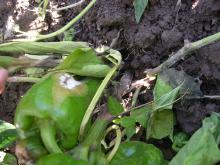See:
Pepper (Capsicum spp.) - Gray Mold
Cause The soilborne fungus, Sclerotinia sclerotiorum, can attack many broad-leaved plants, including pepper, snap bean, carrot, chickpea, cucumber, cabbage, cauliflower, lentil, field pea, potato, squash, and radish. Many broad-leaved weeds are also susceptible, including lambsquarters, Canada thistle, ragweed, and marsh elder. Members of the grass family including small grains, corn and grassy weeds are considered immune.
The pathogen survives as sclerotia in or on the soil. Sclerotia may survive six years or longer. After a moisture-conditioning period, the sclerotia germinate to produce tiny mushroom-like bodies (apothecia), which produce millions of airborne spores. The spores can be produced not only in peppers fields, but also in fields of other crops, including in fields where small grains are rotated after a previously-infected crop. The spores may be windborne to nearby fields where they can infect senescing tissue such as flower blossoms or older leaves. Sometimes sclerotia will germinate and colonize plant debris. After colonizing dead or dying plant tissues, the fungus can then invade healthier parts of plants with which it comes in contact. Moist conditions within the plant canopy favor infection, as do rain, dew, and/or irrigation practices that keep foliage wet for long periods. Fields in low areas or adjacent to rivers can be especially prone to outbreaks.
Symptoms The disease is mainly on aboveground parts, producing a soft, watery rot. Diseased tissues eventually bleach white. Sclerotia that are black on the surface and white inside, associated with this bleached tissue, are diagnostic.
Cultural control
- Avoid planting adjacent to a field area affected the previous season with white mold.
- Rotate using nonsusceptible crops such as grass or grains.
- Encourage maximum air movement between plants.
Chemical control
In fields with a history of white mold, apply fungicides at petal fall. A second application may be necessary with high disease pressure.
- Carboxamide (Group 7) formulations are registered for use on pepper for other diseases and so can be used in Oregon for white mold. Do not make more than two (2) sequential applications before alternating to a labeled fungicide with a different mode of action.
- Endura at 3.5 oz/A is the rate labeled for other diseases on pepper but this rate may be too low for white mold control. Preharvest interval is 0 days. 12-hr reentry.
- Fontelis at 24 fl oz/A. Preharvest interval is 0 days. 12-hr reentry.
Biological control
- Bexfond at 7 to 28 fl oz/A. 4-hr reentry. O
- Contans WG at 1 to 4 lb/A, depending on depth of incorporation, as a preplant or postharvest treatment. Incorporate thoroughly in the top 2 inches of soil. 4-hr reentry. O



